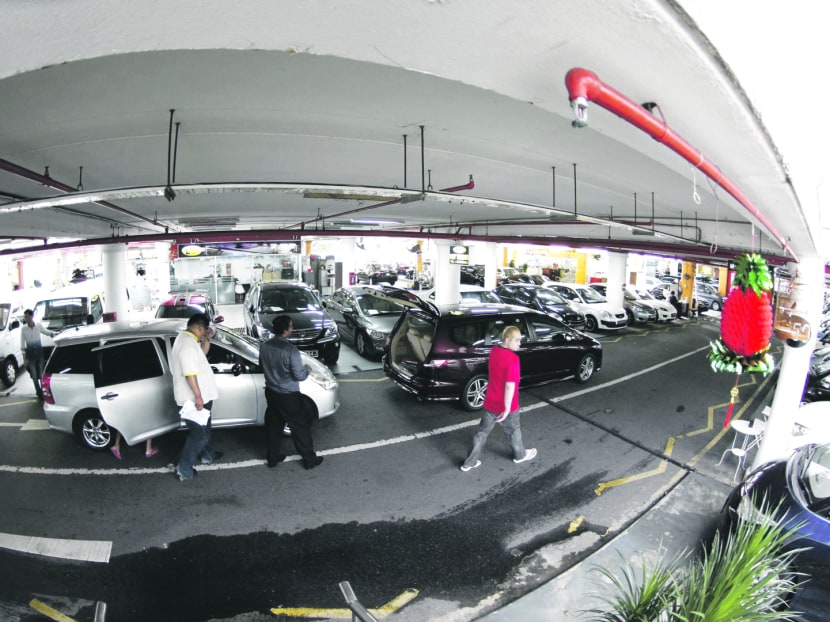Buying a ‘COE car’? Here are some pointers
SINGAPORE — Purchasing a car in Singapore might be a daunting prospect for those with leaner wallets. But who said buying new was the only option?

You can find many cheap used cars, but do your due diligence before making a purchase to avoid disappointment. TODAY file photo
SINGAPORE — Purchasing a car in Singapore might be a daunting prospect for those with leaner wallets. But who said buying new was the only option?
Singapore has a fairly robust used car market, with an average of around 9,000 private cars undergoing a change of ownership every month. Figures from the Land Transport Authority show that three out of 10 cars here are more than eight years old.
Needless to say, the older the car, the cheaper it tends to be. You can even get one for S$20,000. Really. Just check any used car website, and you will find such cars up for sale.
The catch? Most of them are coming close to the end of their 10-year Certificate Of Entitlement (COE) lifespan. A car whose COE clock has run out has to be deregistered, scrapped or re-exported, unless its COE is renewed. So buying a “COE car”, as they are called, is a temporary solution. However, if you intend to search for one, this is what you must know.
LEARN TO APPRECIATE DEPRECIATION
The true cost of owning a car is its depreciation: Basically, it is how much you pay, minus how much you sell it for. Cars in Singapore that are less than 10 years old come with a “scrap value” — a tax rebate paid in cash that owners get for deregistering a car. When a car is scrapped, the rebate amount is half of the additional registration fees that the first owner paid when he bought the car.
Depreciation also takes into account the remaining value of the car’s COE. This scrap value is also known as the PARF/COE rebate, and you can use the LTA’s online e-service to do the sums for you.
On one website, we found a Mitsubishi Lancer 1.6 GLX priced at S$16,800. Registered on April 11, 2008, it has just under a year to go before it heads for the great carpark in the sky. Its cash rebate is S$5,790, which means it depreciates by S$10,830 for the year.
Interestingly, a car that is more expensive could actually be cheaper to own, if it depreciates less steeply. A Suzuki SX4 listed for S$18,000, with 16 months left on its COE and a scrap value of S$6,392, actually depreciates by just S$8,819 a year.
CHOOSE A COMMON MODEL
Due to wear and tear, older cars need more maintenance than new ones. One simple trick to keep such costs in check is to choose a car that is ubiquitous. That way, spare parts are readily available, and anyone who knows the business end of a screwdriver will probably be able to fix it.
Also, try to choose a basic car aimed at budget buyers. These tend to come with fewer frills, which means fewer things can go wrong; and they were designed to be cheap to run in the first place.
The last thing you want is to buy a fixer-upper that only has months left on its COE. If the car requires a big repair job, then it is essentially a very expensive paperweight.
FORGET THE ODOMETER
Try not to be swayed by a low mileage on the odometer. Mileage tampering is actually easier now than when analogue odometers were used, and someone who is unscrupulous could wipe tens of thousands of kilometres off a car’s odometer with a few presses of a button.
Instead, bring a mechanically minded friend along when you check out a used car; or offer to pay for a mechanic to give the car a quick inspection. A number of reputable workshops also offer pre-owned car inspection services for S$200 or more, but this is a small price to pay to avoid any snags.
Failing that, look for the three basic things that tell you to walk away from a used car. One, leaks (check around the engine, under the car and the suspension arms); two, smoke (a small puff on start-up is fine, black smoke signals a tune-up is needed, but blue or white smoke are catastrophic); and finally, look for crooked body panels, uneven panel gaps, or non-standard paint schemes that might signal accident damage.
LOWER YOUR EXPECTATIONS
Needless to say, older cars have fewer modern features. Anything older than eight years is unlikely to come with a Bluetooth sound system or satellite navigation. It may also have worn upholstery and smell a bit like the previous owner’s favourite perfume; but a thorough car-grooming session will usually cancel out much of the seven-year funk.
CONSIDER SAFETY FEATURES
Generally speaking, safety standards get more stringent with time. That means older cars passed crash tests that were more lax, compared to today’s standards; and the older it is, the less crashworthy the car is — a new Hyundai is much safer than a 20-year-old Volvo.
Although airbags have been around for years, some safety technologies only became widespread more recently, such as stability control (which helps to prevent accidents in the first place), and the much stronger high-tensile steel that car makers recently adopted.
STUDY THE MONEY FACTOR
As cheap as a S$20,000 car seems, it might actually make more sense to go with a new car. For instance, a brand-new Mitsubishi Lancer EX costs S$86,999 with COE. With a scrap value of around S$7,200, it actually depreciates by just S$7,980 a year — which makes it much “cheaper” than the GLX.
Of course, it really depends on why you want the car, but as that old phrase goes, caveat emptor. You cannot really go wrong with that.





